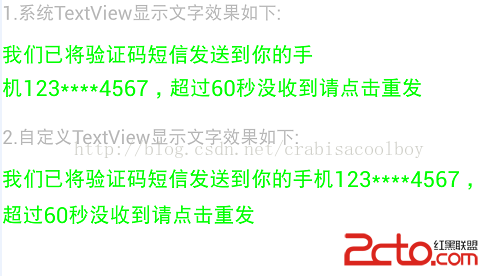編輯:關於Android編程
本文匯總了android 8種對話框(Dialog)使用方法,分享給大家供大家參考,具體內容如下
1.寫在前面
Android提供了豐富的Dialog函數,本文介紹最常用的8種對話框的使用方法,包括普通(包含提示消息和按鈕)、列表、單選、多選、等待、進度條、編輯、自定義等多種形式,將在第2部分介紹。
有時,我們希望在對話框創建或關閉時完成一些特定的功能,這需要復寫Dialog的create()、show()、dismiss()等方法,將在第3部分介紹。
2.代碼示例
2.1 普通Dialog(圖1與圖2)
2個按鈕
public class MainActivity extends Activity {
@Override
protected void onCreate(Bundle savedInstanceState) {
super.onCreate(savedInstanceState);
setContentView(R.layout.activity_main);
Button buttonNormal = (Button) findViewById(R.id.button_normal);
buttonNormal.setOnClickListener(new View.OnClickListener() {
@Override
public void onClick(View v) {
showNormalDialog();
}
});
}
private void showNormalDialog(){
/* @setIcon 設置對話框圖標
* @setTitle 設置對話框標題
* @setMessage 設置對話框消息提示
* setXXX方法返回Dialog對象,因此可以鏈式設置屬性
*/
final AlertDialog.Builder normalDialog =
new AlertDialog.Builder(MainActivity.this);
normalDialog.setIcon(R.drawable.icon_dialog);
normalDialog.setTitle("我是一個普通Dialog")
normalDialog.setMessage("你要點擊哪一個按鈕呢?");
normalDialog.setPositiveButton("確定",
new DialogInterface.OnClickListener() {
@Override
public void onClick(DialogInterface dialog, int which) {
//...To-do
}
});
normalDialog.setNegativeButton("關閉",
new DialogInterface.OnClickListener() {
@Override
public void onClick(DialogInterface dialog, int which) {
//...To-do
}
});
// 顯示
normalDialog.show();
}
}
3個按鈕
/* @setNeutralButton 設置中間的按鈕
* 若只需一個按鈕,僅設置 setPositiveButton 即可
*/
private void showMultiBtnDialog(){
AlertDialog.Builder normalDialog =
new AlertDialog.Builder(MainActivity.this);
normalDialog.setIcon(R.drawable.icon_dialog);
normalDialog.setTitle("我是一個普通Dialog").setMessage("你要點擊哪一個按鈕呢?");
normalDialog.setPositiveButton("按鈕1",
new DialogInterface.OnClickListener() {
@Override
public void onClick(DialogInterface dialog, int which) {
// ...To-do
}
});
normalDialog.setNeutralButton("按鈕2",
new DialogInterface.OnClickListener() {
@Override
public void onClick(DialogInterface dialog, int which) {
// ...To-do
}
});
normalDialog.setNegativeButton("按鈕3", new DialogInterface.OnClickListener() {
@Override
public void onClick(DialogInterface dialog, int which) {
// ...To-do
}
});
// 創建實例並顯示
normalDialog.show();
}
2.2 列表Dialog(圖3)
private void showListDialog() {
final String[] items = { "我是1","我是2","我是3","我是4" };
AlertDialog.Builder listDialog =
new AlertDialog.Builder(MainActivity.this);
listDialog.setTitle("我是一個列表Dialog");
listDialog.setItems(items, new DialogInterface.OnClickListener() {
@Override
public void onClick(DialogInterface dialog, int which) {
// which 下標從0開始
// ...To-do
Toast.makeText(MainActivity.this,
"你點擊了" + items[which],
Toast.LENGTH_SHORT).show();
}
});
listDialog.show();
}
2.3 單選Dialog(圖4)
int yourChoice;
private void showSingleChoiceDialog(){
final String[] items = { "我是1","我是2","我是3","我是4" };
yourChoice = -1;
AlertDialog.Builder singleChoiceDialog =
new AlertDialog.Builder(MainActivity.this);
singleChoiceDialog.setTitle("我是一個單選Dialog");
// 第二個參數是默認選項,此處設置為0
singleChoiceDialog.setSingleChoiceItems(items, 0,
new DialogInterface.OnClickListener() {
@Override
public void onClick(DialogInterface dialog, int which) {
yourChoice = which;
}
});
singleChoiceDialog.setPositiveButton("確定",
new DialogInterface.OnClickListener() {
@Override
public void onClick(DialogInterface dialog, int which) {
if (yourChoice != -1) {
Toast.makeText(MainActivity.this,
"你選擇了" + items[yourChoice],
Toast.LENGTH_SHORT).show();
}
}
});
singleChoiceDialog.show();
}
2.4 多選Dialog(圖5)
ArrayList<Integer> yourChoices = new ArrayList<>();
private void showMultiChoiceDialog() {
final String[] items = { "我是1","我是2","我是3","我是4" };
// 設置默認選中的選項,全為false默認均未選中
final boolean initChoiceSets[]={false,false,false,false};
yourChoices.clear();
AlertDialog.Builder multiChoiceDialog =
new AlertDialog.Builder(MainActivity.this);
multiChoiceDialog.setTitle("我是一個多選Dialog");
multiChoiceDialog.setMultiChoiceItems(items, initChoiceSets,
new DialogInterface.OnMultiChoiceClickListener() {
@Override
public void onClick(DialogInterface dialog, int which,
boolean isChecked) {
if (isChecked) {
yourChoices.add(which);
} else {
yourChoices.remove(which);
}
}
});
multiChoiceDialog.setPositiveButton("確定",
new DialogInterface.OnClickListener() {
@Override
public void onClick(DialogInterface dialog, int which) {
int size = yourChoices.size();
String str = "";
for (int i = 0; i < size; i++) {
str += items[yourChoices.get(i)] + " ";
}
Toast.makeText(MainActivity.this,
"你選中了" + str,
Toast.LENGTH_SHORT).show();
}
});
multiChoiceDialog.show();
}
2.5 等待Dialog(圖6)
private void showWaitingDialog() {
/* 等待Dialog具有屏蔽其他控件的交互能力
* @setCancelable 為使屏幕不可點擊,設置為不可取消(false)
* 下載等事件完成後,主動調用函數關閉該Dialog
*/
ProgressDialog waitingDialog=
new ProgressDialog(MainActivity.this);
waitingDialog.setTitle("我是一個等待Dialog");
waitingDialog.setMessage("等待中...");
waitingDialog.setIndeterminate(true);
waitingDialog.setCancelable(false);
waitingDialog.show();
}
2.6 進度條Dialog(圖7)
private void showProgressDialog() {
/* @setProgress 設置初始進度
* @setProgressStyle 設置樣式(水平進度條)
* @setMax 設置進度最大值
*/
final int MAX_PROGRESS = 100;
final ProgressDialog progressDialog =
new ProgressDialog(MainActivity.this);
progressDialog.setProgress(0);
progressDialog.setTitle("我是一個進度條Dialog");
progressDialog.setProgressStyle(ProgressDialog.STYLE_HORIZONTAL);
progressDialog.setMax(MAX_PROGRESS);
progressDialog.show();
/* 模擬進度增加的過程
* 新開一個線程,每個100ms,進度增加1
*/
new Thread(new Runnable() {
@Override
public void run() {
int progress= 0;
while (progress < MAX_PROGRESS){
try {
Thread.sleep(100);
progress++;
progressDialog.setProgress(progress);
} catch (InterruptedException e){
e.printStackTrace();
}
}
// 進度達到最大值後,窗口消失
progressDialog.cancel();
}
}).start();
}
2.7 編輯Dialog(圖8)
private void showInputDialog() {
/*@setView 裝入一個EditView
*/
final EditText editText = new EditText(MainActivity.this);
AlertDialog.Builder inputDialog =
new AlertDialog.Builder(MainActivity.this);
inputDialog.setTitle("我是一個輸入Dialog").setView(editText);
inputDialog.setPositiveButton("確定",
new DialogInterface.OnClickListener() {
@Override
public void onClick(DialogInterface dialog, int which) {
Toast.makeText(MainActivity.this,
editText.getText().toString(),
Toast.LENGTH_SHORT).show();
}
}).show();
}
2.8 自定義Dialog(圖9)
<!-- res/layout/dialog_customize.xml-->
<!-- 自定義View -->
<LinearLayout xmlns:android="http://schemas.android.com/apk/res/android"
android:orientation="vertical"
android:layout_width="match_parent"
android:layout_height="match_parent">
<EditText
android:id="@+id/edit_text"
android:layout_width="match_parent"
android:layout_height="wrap_content"
/>
</LinearLayout>
private void showCustomizeDialog() {
/* @setView 裝入自定義View ==> R.layout.dialog_customize
* 由於dialog_customize.xml只放置了一個EditView,因此和圖8一樣
* dialog_customize.xml可自定義更復雜的View
*/
AlertDialog.Builder customizeDialog =
new AlertDialog.Builder(MainActivity.this);
final View dialogView = LayoutInflater.from(MainActivity.this)
.inflate(R.layout.dialog_customize,null);
customizeDialog.setTitle("我是一個自定義Dialog");
customizeDialog.setView(dialogView);
customizeDialog.setPositiveButton("確定",
new DialogInterface.OnClickListener() {
@Override
public void onClick(DialogInterface dialog, int which) {
// 獲取EditView中的輸入內容
EditText edit_text =
(EditText) dialogView.findViewById(R.id.edit_text);
Toast.makeText(MainActivity.this,
edit_text.getText().toString(),
Toast.LENGTH_SHORT).show();
}
});
customizeDialog.show();
}
3.復寫回調函數
/* 復寫Builder的create和show函數,可以在Dialog顯示前實現必要設置
* 例如初始化列表、默認選項等
* @create 第一次創建時調用
* @show 每次顯示時調用
*/
private void showListDialog() {
final String[] items = { "我是1","我是2","我是3","我是4" };
AlertDialog.Builder listDialog =
new AlertDialog.Builder(MainActivity.this){
@Override
public AlertDialog create() {
items[0] = "我是No.1";
return super.create();
}
@Override
public AlertDialog show() {
items[1] = "我是No.2";
return super.show();
}
};
listDialog.setTitle("我是一個列表Dialog");
listDialog.setItems(items, new DialogInterface.OnClickListener() {
@Override
public void onClick(DialogInterface dialog, int which) {
// ...To-do
}
});
/* @setOnDismissListener Dialog銷毀時調用
* @setOnCancelListener Dialog關閉時調用
*/
listDialog.setOnDismissListener(new DialogInterface.OnDismissListener() {
public void onDismiss(DialogInterface dialog) {
Toast.makeText(getApplicationContext(),
"Dialog被銷毀了",
Toast.LENGTH_SHORT).show();
}
});
listDialog.show();
}
以上就是本文的全部內容,希望對大家的學習有所幫助。
 Android---簡單的JNI實例
Android---簡單的JNI實例
一、JNI概述 JNI 是Java Native Interface的縮寫,中文翻譯為“Java本地調用”,JNI 是本地編程接口。它使得在 Java 虛擬機 (VM)
 Android操作SQLite數據庫(增、刪、改、查、分頁等)及ListView顯示數據的方法詳解
Android操作SQLite數據庫(增、刪、改、查、分頁等)及ListView顯示數據的方法詳解
本文實例講述了Android操作SQLite數據庫(增、刪、改、查、分頁等)及ListView顯示數據的方法。分享給大家供大家參考,具體如下:由於剛接觸android開發
 Android TextView顯示文字對齊
Android TextView顯示文字對齊
有時候利用android的TextView顯示中文跟數字的組合會對不齊,如下面截圖,文字還沒有到達屏幕右邊就開始換行了為了解決這個文字,自己子定義了一個TextView的
 Android仿淘寶view滑動至屏幕頂部會一直停留在頂部的位置
Android仿淘寶view滑動至屏幕頂部會一直停留在頂部的位置
在剛剛完成的項目中,在一個頁面中,用戶體驗師提出引用戶操作的入住按鈕要一直保留在頁面當中,不管頁面能滾動多長都得停留在頁面的可視區域。最終實現效果如下圖所示: